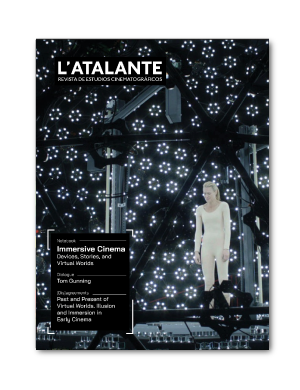Published 2023-01-31
Keywords
- 360-degree Cinema,
- Immersive Cinema,
- Panorama,
- Body,
- Movement
- Train,
- Travel. ...More
How to Cite
Copyright (c) 2023 L'Atalante. Journal of film studies

This work is licensed under a Creative Commons Attribution-NonCommercial-NoDerivatives 4.0 International License.
Abstract
The way that conventional cinema guides the spectator around the image constitutes a very different form of immersion from the interactive immersion of all-encompassing media experiences. By considering such differences when studying immersive media, we can explore the full range of its potential benefits and how they can be combined to create new narrative formulas. Beyond virtualizing scenes, every immersive medium repositions the movement and the body of the spectator in the represented space. How these elements are redefined in each production is central to the viewing experience. This article studies immersive audiovisual storytelling, particularly in 360-degree video, from the perspective of the frictions between conventional cinematography and immersive media. These tensions are expressed through the different ways in which movement is depicted and the different positions of the spectator’s body in the image.
Downloads
References
Benjamin, W. (1989). Discursos Interrumpidos I. Taurus.
Benjamin, W. (2010). Ensayos escogidos. El cuenco de plata
Burch, N. (2011). El tragaluz del infinito. Cátedra.
Fielding, R. (1970). Hale's Tours: Ultrarealism in the Pre-1910 Motion Picture. Cinema Journal, 10(1), 34-47.
Griffith, A. (2006). Time Traveling IMAX Style: Tales from the Giant Screen. En J. Ruoff (ed.), Virtual voyages: Cinema and travel (pp. 238-258). Duke University Press.
Hayes, C. (2009). Phantom carriages: Reconstructing Hale’s Tours and the virtual travel experience. Early Popular Visual Culture, 7(2), 185-198.
Metz, C. (2001). El significante imaginario: Psicoanálisis del cine. Paidós.
Schivelbusch, W. (1986). The railway journey: The industrialization of time and space in the nineteenth century. Univ of California Press.
Sobchack, V. (2004). Carnal Thoughts: Embodiment and Moving Image Culture. University of California Press.
Uricchio, W. (2011). A ‘proper point of view’: The panorama and some of its early media iterations. Early Popular Visual Culture, 9(1), 225-238.
Zone, R. (2012). 3-D revolution: The history of modern stereoscopic cinema. University Press of Kentucky.
Webs:
Kinepolis España. (s.f.). 4DX. Recuperado el 18 de abril de 2022 de https://kinepolis.es/movie-formats/4dx
Palacio del cine. (s.f.). Años de Cinerama desde Nueva York. Recuperado el 8 de mayo de 2018 de: http://palacio-del-cine.blogspot.com

